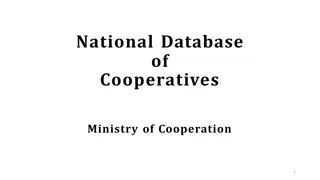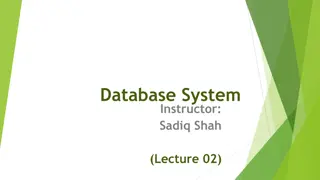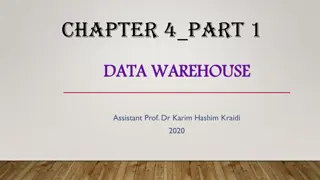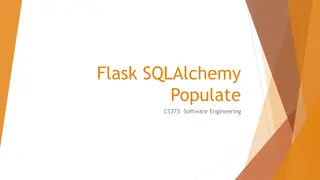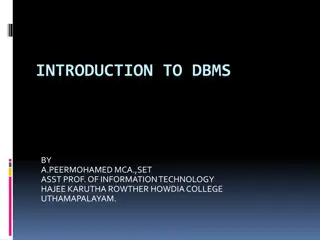Introduction to Database Management System Explained
This presentation covers the basics of database management systems, including definitions of data, types of data, structured and unstructured data, storing data in computers using file systems and database systems, and issues with file systems like data redundancy, inconsistency, difficult data access, and unauthorized access. It provides insights into the importance of managing data efficiently and the differences between file systems and database systems.
Download Presentation

Please find below an Image/Link to download the presentation.
The content on the website is provided AS IS for your information and personal use only. It may not be sold, licensed, or shared on other websites without obtaining consent from the author. Download presentation by click this link. If you encounter any issues during the download, it is possible that the publisher has removed the file from their server.
E N D
Presentation Transcript
Introduction to Database Management System By Mrs.Muneeswari
Agenda What is Data? Types of Data Structured Data and Unstructured Data How do we store Data into Computers ? File System Vs Database System File System Issues What is Management? What is DBMS?
What is Data? From Dictionary : Factual information (such as measurements or statistics) used as a basis for reasoning, discussion, or calculation From Wikipedia : Data are characteristics , usually numerical, that are collected through observation. In a more technical sense, data is a set of values of qualitative or quantitative variables about one or more persons or objects, while a datum (singular of data) is a single value of a single variable. Example: Name, Address, Zip, SSN are characteristics or information about a person.
Types of Data Unstructured-Data Structured Information (interpreted data data supplied with semantics)
How do we store Data into Computers?. Data could be stored computers in File System and or Database Management and or content management systems. Let us focus on File System and Database approaches . Each one has its own advantages and disadvantages.
File System Vs Database System File System Database System
File System Vs Database System Cont File System Database System
File System Issues Redundancy of data: Data is said to be redundant if same data is copied at many places. If a student wants to change Phone number, he has to get it updated at various sections. Similarly, old records must be deleted from all sections representing that student. Inconsistency of Data: Data is said to be inconsistent if multiple copies of same data does not match with each other. If Phone number is different in Accounts Section and Academics Section, it will be inconsistent. Inconsistency may be because of typing errors or not updating all copies of same data. Difficult Data Access: A user should know the exact location of file to access data, so the process is very cumbersome and tedious. If user wants to search student hostel allotment number of a student from 10000 unsorted students records, how difficult it can be. Unauthorized Access: File System may lead to unauthorized access to data. If a student gets access to file having his marks, he can change it in unauthorized way. No Concurrent Access: The access of same data by multiple users at same time is known as concurrency. File system does not allow concurrency as data can be accessed by only one user at a time. No Backup and Recovery: File system does not incorporate any backup and recovery of data if a file is lost or corrupted.
What is Management? Generally Management refers create, Retrieve, update and delete. For example: Money Management refers earning the money, querying money, distribute the money and spend the money.
What is Database? Database: Database is a collection of inter-related data which helps in efficient retrieval, insertion and deletion of data from database and organizes the data in the form of tables, views, schemas, reports etc. For Example, university database organizes the data about students, faculty, and admin staff etc. which helps in efficient retrieval, insertion and deletion of data from it. Now Database Management talks about Create Database Retrieve(View) database Update database Delete Database
What is DBMS? Database Management System: The software which is used to manage database is called Database Management System (DBMS). For Example, MySQL, Oracle etc. are popular commercial DBMS used in different applications. DBMS allows users the following tasks: Data Definition: It helps in creation, modification and removal of definitions that define the organization of data in database. Data Updation: It helps in insertion, modification and deletion of the actual data in the database. Data Retrieval: It helps in retrieval of data from the database which can be used by applications for various purposes. User Administration: It helps in registering and monitoring users, enforcing data security, monitoring performance, maintaining data integrity, dealing with concurrency control and recovering information corrupted by unexpected failure.
Database Languages A database system provides a data definition language to specify the database schema and a data manipulation language to express database queries and updates. In practice, the data definition and data manipulation languages are not two separate languages; instead they simply form parts of a single database language, such as the widely used SQL language




